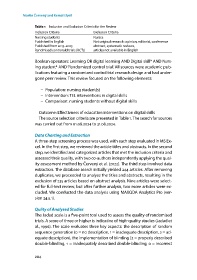Page 204 - International Perspectives on Effective Teaching and Learning in Digital Education
P. 204
Martin Červený and Kemal Elyeli
Table 1 Inclusion and Exclusion Criteria for the Review
Inclusion Criteria Exclusion Criteria
Nursing students Nurses
Published in English Not original research: opinion, editorial, conference
Published from 13–3 abstract, systematic reviews,
Randmised controrold trials (RCTs) articles not available in English
Boolean operators: Learning OR digital learning AND Digital skill* AND Nurs-
ing student* AND ‘Randomized control trial.’ All sources were academic pub-
lications featuring a randomized control trial research design and had under-
gone peer review. This review focused on the following elements:
− Population: nursing student(s)
− Intervention: TEL interventions in digital skills
− Comparison: nursing students without digital skills
Outcome: Effectivness of education interventions on digital skills
The source selection criteria are presented in Table 1. The search for sources
was carried out from 1.8.4 to 31.8.4.
Data Charting and Extraction
A three-step screening process was used, with each step evaluated in MS Ex-
cel. In the first step, we reviewed the article titles and abstracts. In the second
step, we identified and categorized articles that met the inclusion criteria and
assessed their quality, with two co-authors independently applying the qual-
ity assessment method by Červený et al. (). The third step involved data
extraction. The database search initially yielded 44 articles. After removing
duplicates, we proceeded to analyze the titles and abstracts, resulting in the
exclusion of 35 articles based on abstract analysis. Nine articles were select-
ed for full-text review, but after further analysis, two more articles were ex-
cluded. We conducted the data analysis using MAXQDA Analytics Pro (ver-
sion 4.5.1).
Qulity of Analysed Studies
The Jadad scale is a five-point tool used to assess the quality of randomised
trials. A score of three or higher is indicative of high-quality studies (Jadad et
al., 1996). The scale evaluates three key aspects: the description of random
sequence generation ( = no description, 1 = inadequate description, = ad-
equate description), the implementation of blinding ( = properly described
double-blinding, 1 = inadequately described double-blinding, = incorrect
4

